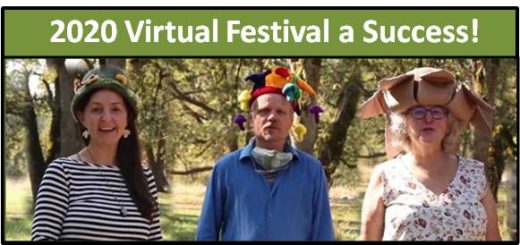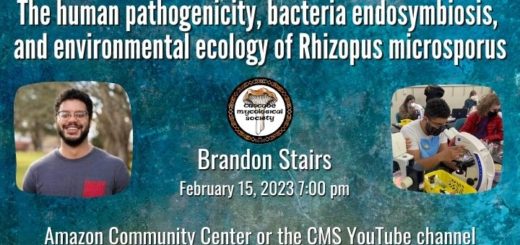The Dark Fungi and the Light Fungi
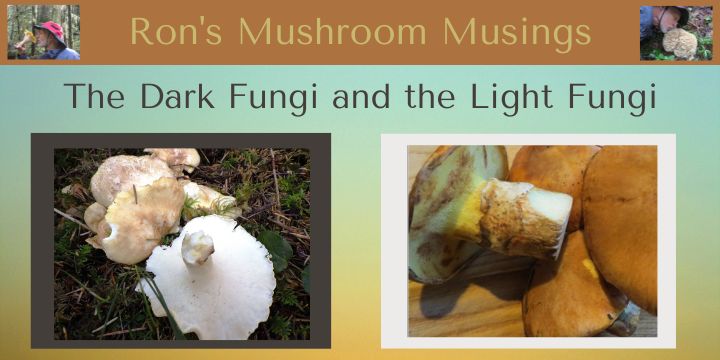
If the title of this article seems confusing to you, well you’re probably in very good company. On a recent PBS broadcast of Science Friday, one of the topics of discussion was all about “Dark Fungi”. Now, do not confuse Dark Fungi with Black Fungi, Black Fungus, or Dark Side. Black fungi are an ecological group of melanized fungi (to make dark or black) specialized in tolerating extreme environments and assumed to be among the most stress-resistant eukaryotes (any organism that possesses a clearly defined nucleus) on Earth. Black Fungus , according to WebMD, is a rare but dangerous infection caused by a group of molds called mucormycetes, which often affects the sinuses, lungs, skin, and brain. The Dark Side was an area of space that Darth Vader and Dick Cheney, who said: “we have to work the Dark Side”, operated inside of.
Dark Fungi, on the other hand, is described in this paragraph taken from the Science Friday website. “Scientists have collected DNA samples of thousands of new fungus species over the past several decades. These fragments of fungal DNA are found nearly everywhere in soil, decomposing logs, water, and even in the air. Mycologists have enough data to place these new species within the fungal family tree, but haven’t collected physical samples of them or been able to grow them in a lab. This means that according to the International Code of Nomenclature for algae, fungi, and plants, these new species cannot receive scientific names.”
The current process being used to detect Dark Fungi and other organisms in various samples is referred to as Metabarcoding. Wikipedia describes the process of Metabarcoding as “The barcoding of DNA/RNA (or eDNA/eRNA) in a manner that allows for the simultaneous identification of many taxa within the same sample. The main difference between barcoding and metabarcoding is that metabarcoding does not focus on one specific organism, but instead aims to determine species composition within a sample.”
There is a great deal of debate regarding the degree of importance of Dark Fungi. Eric Ralls, founder and CEO of earth.com, expresses the significance of this research as follows; “Uncovering the mysteries of dark fungi could potentially lead to breakthroughs in various scientific fields, from ecology and evolution to nature conservation and ecosystem analysis. As we continue to explore this enigmatic domain, the full extent of fungi’s influence on our world may soon be brought to light.” Creating a better understating of Dark Fungi is quite exciting and hopefully changes will be made to allow scientific naming of these DNA fragments. In the mean time, I say we give these Dark Fungi all common names and assign scientific ones if and when the members of the International Code group get their act together. At least this way we can finally bring these fungi out of the darkness.
Fortunately, What I’ve named Light Fungi is far less complicated as it relates to those fungi that do create fruiting bodies and can been given scientific names as well as clever common ones. Two of these Light Fungi that Sandy and I recently encountered are scientifically named Albatrellus avellaneus and Suillus ponderosus. These are two mushroom species we often find at the coast and finally decided to give them the taste test. As for their culinary usefulness, well that depends on which mushroom book you read. They both seem to span the gamut of being good edibles to don’t bother. Consequently, we wanted to find out for ourselves.

Albatrellus avellaneus is a fairly easy mushroom to identify and is quite common in our coastal areas. We mostly find it growing with Sitka spruce; although, it can also be found fruiting around other conifer species as well. The cap color can confuse you into thinking you’ve found a hedgehog mushroom until you look under the cap to find pores in place of spines. It is a very solid mushroom and its closest look-alike, Albatrellus ovinus, has more of a cream-colored cap. Both are found within the same areas along the coast and both are edible. We sautéed A. avellaneus in our typical way using butter, granulated garlic, and a touch of salt. After the mushroom slices obtained that golden hue, they were ready for the taste test. Sandy and I both gave this mushroom two thumbs up for both flavor and texture. We had also received an excellent review from very good friends of ours that we had given some of these mushrooms to.
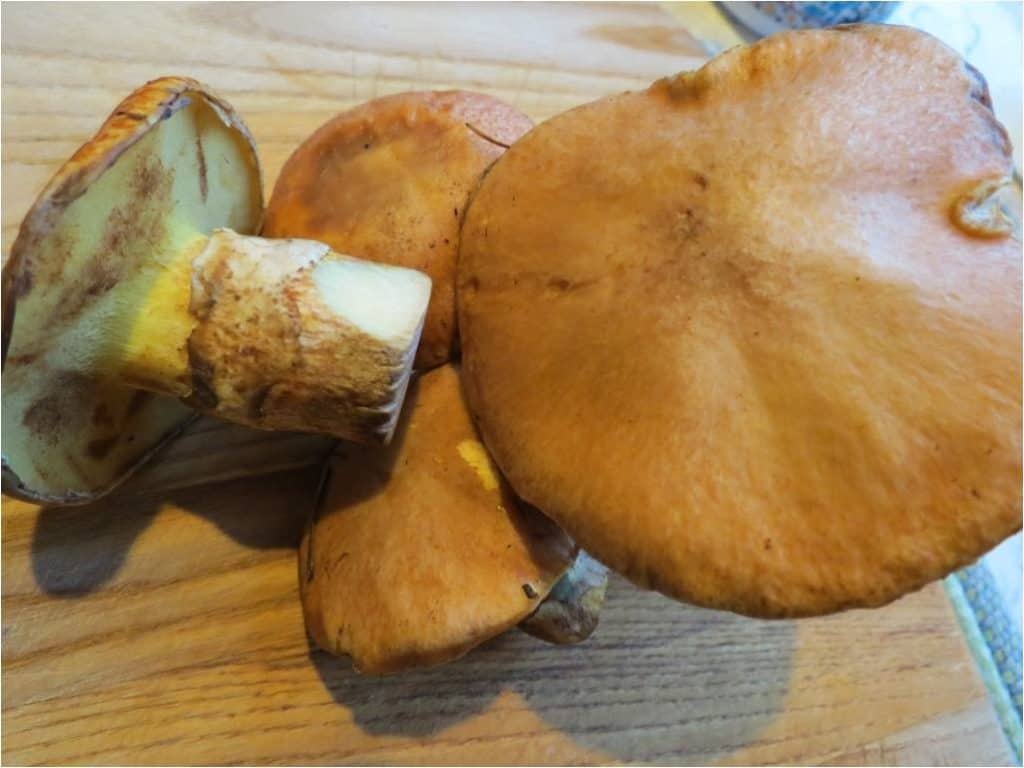
Suillus ponderosus, referred to as “Slimy Fat Jack” in Mushrooms of the Redwood Coast, is considered to be one of the more flavorful mushrooms in the genus Suillus. That is saying a lot as many mushroom books minimize the edibility and culinary usefulness of most of the mushrooms in this genus. Even the genus name “Suillus” is somewhat unflattering as it was derived from the Latin noun sus, meaning pig or swine. And, to add insult to injury, most of the common names for this genus include the name Jack. In the English language Jack, when used as a descriptive word, infers that an item or thing is common or ordinary.
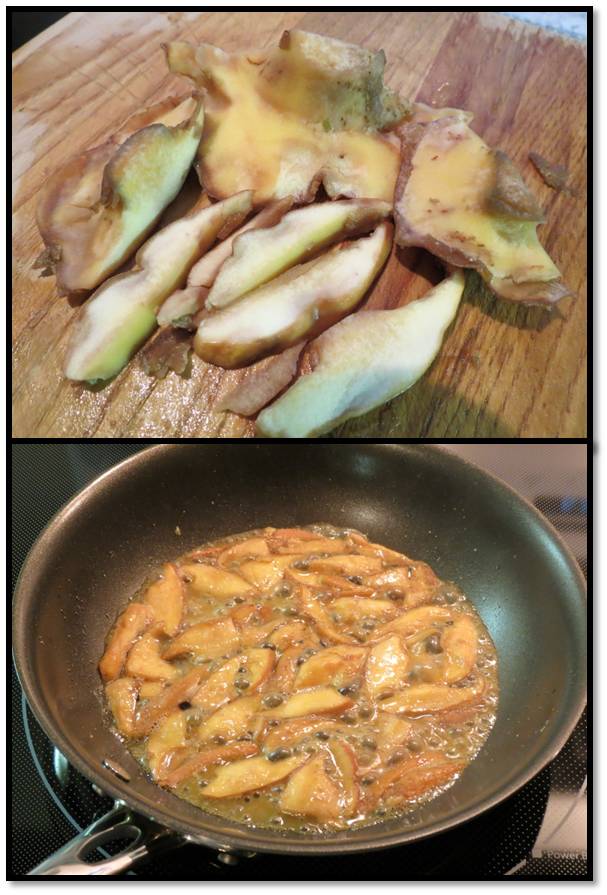
As a result of knowing these root descriptions, we can more accurately refer to Slimy Fat Jack as Slimy Common Fat Pig. Unfortunately, this interpretation does not inspire one to rush out and find this mushroom, nor a desire to eat it. Since few people seem to seek out Suillus species, they are often in great abundance from the coast to the Cascade Mountain range. Suillus ponderosus is also a host fungus to another slime capped parasitic fungus, Gomphidius glutinosus, which David Arora referred to as the “Hideous Gomphidius”. So, don’t be surprised if you see mushrooms from these two fungal species fruiting close by one another. Despite the Slimy Fat Jack’s slanderous names and slimy reputation, Sandy and I jumped at the chance to try this mushroom.
Actually, there was no jumping, it was more like relenting to try it. I must say we were both happy we did. Once we cooked off all the water and browned it off, the flavor was quite pleasing. It was actually not much different than some of the other sponge-bottom mushrooms we’ve eaten. I use the descriptor sponge-bottom as I would run out of space if I used all the new genus names boletes have been split into.
Well, there you have it. The dark and the light. The dark being very interesting but strange and the light being both tangible and quite tasty. So, for now, enjoy finding winter hedgehogs, winter chanterelles, and maybe even a few black trumpets. Although, we recommend you wait until the ice melts! ~ Ron


